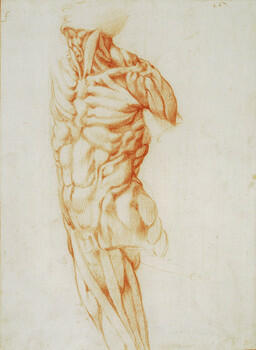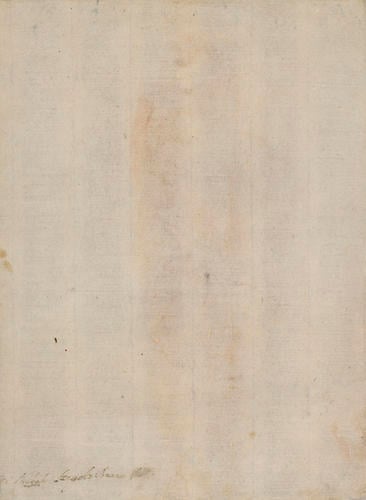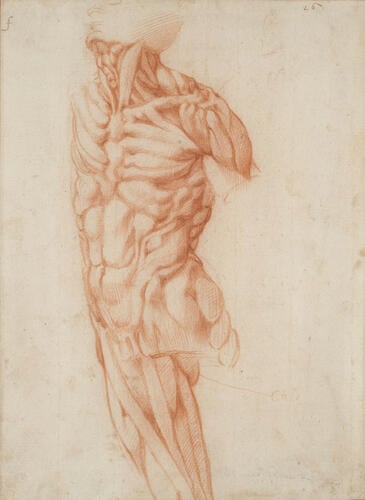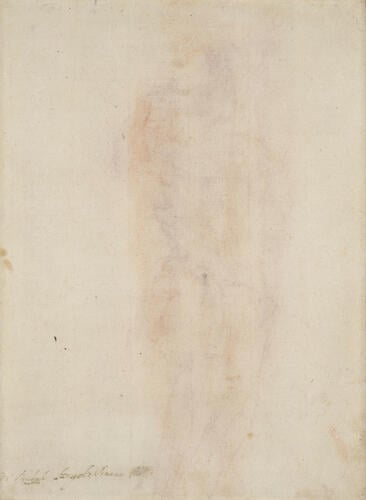-
1 of 253523 objects
A flayed figure c.1520-30
Red chalk | 28.2 x 20.6 cm (sheet of paper) | RCIN 990624

Circle of Michelangelo Buonarroti (Caprese 1475-Rome 1564)
An anatomical study of a male torso c.1520-30

Circle of Michelangelo Buonarroti (Caprese 1475-Rome 1564)
An anatomical study of a male torso c.1520-30




-
A red chalk drawing of a male torso, upper left arm and upper right leg, showing the muscles as if the skin had been stripped (écorché). The same figure, studied from behind by the same artist, is at RCIN 990802, and a study of the right leg from the inside and from behind, at 990803.
The identity of pose and detail establishes that all were drawn from a single wax or clay model, and that model was quite possibly made by Michelangelo. He had conducted dissections of human corpses from an early age, to understand the anatomy of the bones and muscles, and it is likely that he made anatomical models too – though ‘whether the model from which the present drawing was copied was made as a demonstration piece, or whether it was prepared for a particular work of sculpture, is impossible to say’ (P. Joannides, Michelangelo and his Influence, 1996, no. 41).
The attribution of these three drawings uncertain. All were catalogued by J. Wilde (Popham and Wilde 1949, nos. 439-441) as ‘School of Michelangelo’, in the belief that they ‘formed part of a book of anatomical studies, or copies of such studies, used as models in Michelangelo’s studio’. The letters at top left of each sheet (f, M, R) certainly imply that they once formed part of a much larger sequence of such studies. Joannides (loc. cit.) attributed the three drawings to Michelangelo himself, while acknowledging that ‘it remains to be explained why Michelangelo should have copied his own work.’
Michelangelo’s friend and biographer Ascanio Condivi (1553) stated that the artist had in mind the preparation of a treatise on the human body for the use of artists; Condivi was essentially writing an authorised biography at Michelangelo’s behest, and this statement is likely to be substantially correct. The drawings have a smoothness and regularity not usually seen in Michelangelo’s chalk drawings, and this would be understandable if they were models intended, however speculatively, for the use of an engraver. These chalk studies should also be considered alongside further related studies in pen and ink, RCIN 990474-5, whose connection to Michelangelo's certain pen drawings is more easily demonstrable. On balance, the three chalk drawings are not entirely convincing as autograph Michelangelo, but there are so many connections with his work that an attribution might be entertained.A sheet in the Teylers Museum, Haarlem (A.39), in both red chalk and pen, studies a left arm and shoulder on the recto, and a left leg from four directions on the verso; that sheet may also be by the same draughtsman as the three at Windsor, and bears three lines of a madrigal written out in Michelangelo’s distinctive hand. Indeed the drawings collections of the world contain many sheets more or less anatomical in nature and attributed vaguely to the ‘School of Michelangelo’, that together reflect this important aspect of his art.
The present drawing is Inscribed, presumably by the artist, in red chalk at upper right: 'braco', and at lower right: 'culo'. Inscribed by other hands in pen: at upper left: 'f'; at upper right: '26'; on the verso: 'di Michel Angelo Buona Roti'.Provenance
Royal Collection by c.1810; earlier provenance unknown.
-
Creator(s)
-
Medium and techniques
Red chalk
Measurements
28.2 x 20.6 cm (sheet of paper)
Category
Object type(s)
Other number(s)
RL O : Royal Library "O" Number Register – RL O624Alternative title(s)
An anatomical study of a male torso